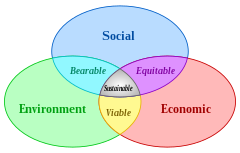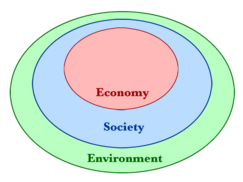This article possibly contains original research. (October 2010) |
| Part of a series on |
| Economics |
|---|
 |
 |
| The three pillars of sustainability. Click on image areas for more information. |

Natural resource economics deals with the supply, demand, and allocation of the Earth's natural resources. One main objective of natural resource economics is to better understand the role of natural resources in the economy in order to develop more sustainable methods of managing those resources to ensure their availability for future generations. Resource economists study interactions between economic and natural systems, with the goal of developing a sustainable and efficient economy.[2]
- ^ Willard, B. (2011). "3 Sustainability Models" citing The Power of Sustainable Thinking by Bob Doppelt, and The Necessary Revolution by Peter Senge et al. Retrieved on: 2011-05-03.
- ^ http://www.uri.edu/cels/enre/ University of Rhode Island Department of Environmental and Natural Resource Economics Retrieved October-22-09